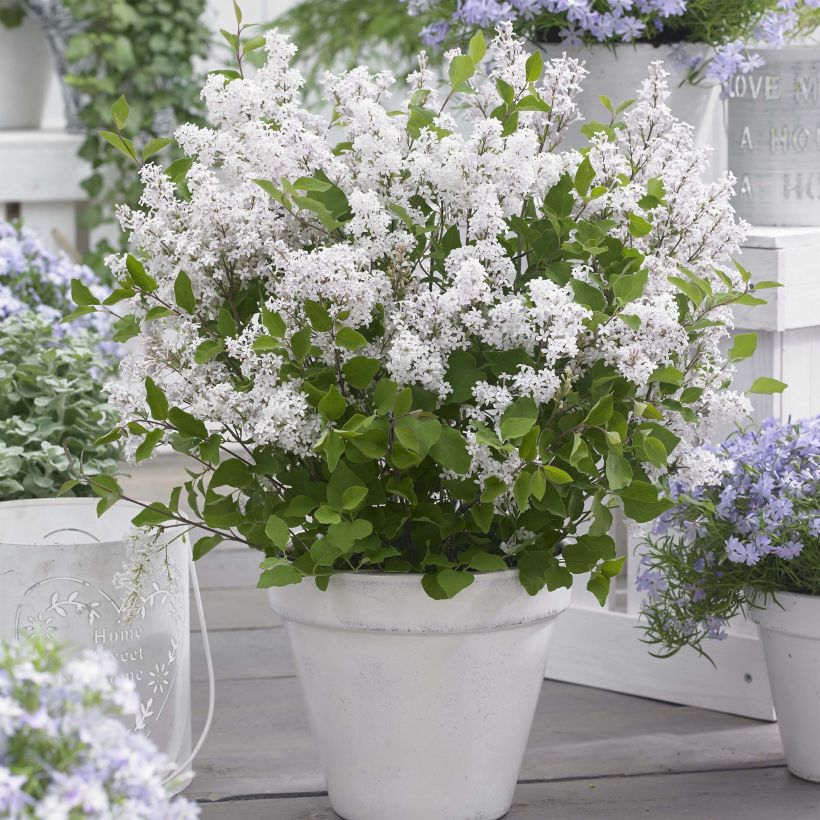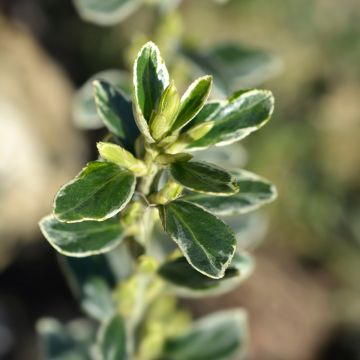

Syringa meyeri Flowerfesta White - Lilac


Syringa meyeri Flowerfesta White - Lilac
View more pictures
Hide images

Emilie D.

Emilie D. • 33 FR
Syringa meyeri Flowerfesta White - Lilac
Syringa meyeri Flowerfesta® White 'Anny200810'
Meyer's Lilac, Dwarf Korean Lilac
Arrived well packaged, without any damage, despite the package being left outside our house by the DPD delivery driver.
Emilie, 21/12/2023
Special offer!
Receive a €20 voucher for any order over €90 (excluding delivery costs, credit notes, and plastic-free options)!
1- Add your favorite plants to your cart.
2- Once you have reached €90, confirm your order (you can even choose the delivery date!).
3- As soon as your order is shipped, you will receive an email containing your voucher code, valid for 3 months (90 days).
Your voucher is unique and can only be used once, for any order with a minimum value of €20, excluding delivery costs.
Can be combined with other current offers, non-divisible and non-refundable.
Home or relay delivery (depending on size and destination)
Schedule delivery date,
and select date in basket
This plant carries a 24 months recovery warranty
More information
We guarantee the quality of our plants for a full growing cycle, and will replace at our expense any plant that fails to recover under normal climatic and planting conditions.
Would this plant suit my garden?
Set up your Plantfit profile →
Description
The Syringa Flowerfesta 'White', like all lilacs from the new Flowerfesta series, is a very hardy bush, small in size, highly floriferous, perpetual and fragrant, perfectly suited to small gardens and pots to adorn the terrace or balcony. Its clusters of single flowers first violet pink when they are in buds, bloom white. They are larger than those of most varieties derived from Syringa meyeri and are produced abundantly in spring, sometimes more sporadically during the summer and very often again in September-October. Not demanding, economical in water, it will also look good in a small flowering hedge, planted in a group or even as a single near the house.
The lilac Flowerfesta 'White' is a recent horticultural creation, belonging to a series of lilacs developed in recent years in the Netherlands. It comes from the Syringa meyeri, native to Northern China, although it has never been found in the wild. The bushes of the Flowerfesta series were selected for their colour, their floriferous nature, the size of their inflorescences and their strongly perpetual character. They come in white, pink and purple. All these plants belong to the oleaceae family.
This lilac naturally forms a rounded, compact and ramified bush, as wide as it is high. When mature, it will not exceed 1.25 m (4 ft 1 in) in all directions. Its growth is quite slow, encouraged by rich and fresh soil. This variety blooms from a young age, abundantly in April-May, a few days before common lilacs, in the form of pleasantly fragrant thyrsus, 10 to 14 cm (3.9 to 5.5 in) long, composed of small single flowers, of pure white colour, even in buds. These inflorescences are grouped in bouquets at the end of the previous year's shoots, then again at the end of summer or beginning of autumn, at the end of the year's branches. This flowering attracts a good number of butterflies and pollinating insects. Its foliage, deciduous, is composed of small elliptical leaves 2 to 4 cm (0.8 to 1.6 in) long, of a medium green.
Whther it is the fragrance, flowers, childhood memories or even as a symbol of a significant event, everyone has a good reason to love lilacs, as endearing as they are devoid of pretension. The Flowerfesta 'White' Lilac perfectly suits a small garden or on a terrace, wherever space is counted. Perfectly hardy, easy to grow in ordinary but drained soil, even in cold or dry region, not demanding, it adapts to all styles of gardens and to all our climates. It constitutes a major element for a scent garden, its flowering accompanying that of brooms, and pink or white genets. It can also be planted in large borders, in groups, as a single or in the form of a free hedge mixed with other trees (flowering apple trees, Japanese cherry trees, Chinese almond trees, forsythias, Japanese quinces, Deutzias...). Its deliciously fragrant clusters are appreciated in spring bouquets, in the company of the first garden irises, early peonies, campanulas and florist's ranunculus.
Report an error about the product description
Syringa meyeri Flowerfesta White - Lilac in pictures






Plant habit
Flowering
Foliage
Botanical data
Syringa
meyeri
Flowerfesta® White 'Anny200810'
Oleaceae
Meyer's Lilac, Dwarf Korean Lilac
Cultivar or hybrid
Other Syringa - Lilac
View all →Planting and care
The Syringa Flowerfesta 'White' is planted from November to September and from March to June. It adapts to any ordinary soil, but it prefers drained, deep, loose soils, not too dry, even limestone. An application of a complete fertiliser every year at the start of the season is recommended. It is preferable to place it in full sun or in light shade in a warm climate, as its flowering is better when it receives maximum light, and the winters are well contrasted. It is useful to cut off the faded inflorescences after flowering to avoid fruiting, which is of no interest and exhausts the plant. This will encourage a resurgence at the end of summer and more abundant flowering the following year. This variety flowers on the shoots of the previous year, but also on the branches of the current year. Pruning is not obligatory on this naturally compact variety. Avoid severe prunings that limit the flowering of the following spring.
Planting period
Intended location
Care
-
, onOrder confirmed
Reply from on Promesse de fleurs
Similar products
Haven't found what you were looking for?
Hardiness is the lowest winter temperature a plant can endure without suffering serious damage or even dying. However, hardiness is affected by location (a sheltered area, such as a patio), protection (winter cover) and soil type (hardiness is improved by well-drained soil).

Photo Sharing Terms & Conditions
In order to encourage gardeners to interact and share their experiences, Promesse de fleurs offers various media enabling content to be uploaded onto its Site - in particular via the ‘Photo sharing’ module.
The User agrees to refrain from:
- Posting any content that is illegal, prejudicial, insulting, racist, inciteful to hatred, revisionist, contrary to public decency, that infringes on privacy or on the privacy rights of third parties, in particular the publicity rights of persons and goods, intellectual property rights, or the right to privacy.
- Submitting content on behalf of a third party;
- Impersonate the identity of a third party and/or publish any personal information about a third party;
In general, the User undertakes to refrain from any unethical behaviour.
All Content (in particular text, comments, files, images, photos, videos, creative works, etc.), which may be subject to property or intellectual property rights, image or other private rights, shall remain the property of the User, subject to the limited rights granted by the terms of the licence granted by Promesse de fleurs as stated below. Users are at liberty to publish or not to publish such Content on the Site, notably via the ‘Photo Sharing’ facility, and accept that this Content shall be made public and freely accessible, notably on the Internet.
Users further acknowledge, undertake to have ,and guarantee that they hold all necessary rights and permissions to publish such material on the Site, in particular with regard to the legislation in force pertaining to any privacy, property, intellectual property, image, or contractual rights, or rights of any other nature. By publishing such Content on the Site, Users acknowledge accepting full liability as publishers of the Content within the meaning of the law, and grant Promesse de fleurs, free of charge, an inclusive, worldwide licence for the said Content for the entire duration of its publication, including all reproduction, representation, up/downloading, displaying, performing, transmission, and storage rights.
Users also grant permission for their name to be linked to the Content and accept that this link may not always be made available.
By engaging in posting material, Users consent to their Content becoming automatically accessible on the Internet, in particular on other sites and/or blogs and/or web pages of the Promesse de fleurs site, including in particular social pages and the Promesse de fleurs catalogue.
Users may secure the removal of entrusted content free of charge by issuing a simple request via our contact form.
The flowering period indicated on our website applies to countries and regions located in USDA zone 8 (France, the United Kingdom, Ireland, the Netherlands, etc.)
It will vary according to where you live:
- In zones 9 to 10 (Italy, Spain, Greece, etc.), flowering will occur about 2 to 4 weeks earlier.
- In zones 6 to 7 (Germany, Poland, Slovenia, and lower mountainous regions), flowering will be delayed by 2 to 3 weeks.
- In zone 5 (Central Europe, Scandinavia), blooming will be delayed by 3 to 5 weeks.
In temperate climates, pruning of spring-flowering shrubs (forsythia, spireas, etc.) should be done just after flowering.
Pruning of summer-flowering shrubs (Indian Lilac, Perovskia, etc.) can be done in winter or spring.
In cold regions as well as with frost-sensitive plants, avoid pruning too early when severe frosts may still occur.
The planting period indicated on our website applies to countries and regions located in USDA zone 8 (France, United Kingdom, Ireland, Netherlands).
It will vary according to where you live:
- In Mediterranean zones (Marseille, Madrid, Milan, etc.), autumn and winter are the best planting periods.
- In continental zones (Strasbourg, Munich, Vienna, etc.), delay planting by 2 to 3 weeks in spring and bring it forward by 2 to 4 weeks in autumn.
- In mountainous regions (the Alps, Pyrenees, Carpathians, etc.), it is best to plant in late spring (May-June) or late summer (August-September).
The harvesting period indicated on our website applies to countries and regions in USDA zone 8 (France, England, Ireland, the Netherlands).
In colder areas (Scandinavia, Poland, Austria...) fruit and vegetable harvests are likely to be delayed by 3-4 weeks.
In warmer areas (Italy, Spain, Greece, etc.), harvesting will probably take place earlier, depending on weather conditions.
The sowing periods indicated on our website apply to countries and regions within USDA Zone 8 (France, UK, Ireland, Netherlands).
In colder areas (Scandinavia, Poland, Austria...), delay any outdoor sowing by 3-4 weeks, or sow under glass.
In warmer climes (Italy, Spain, Greece, etc.), bring outdoor sowing forward by a few weeks.


















































